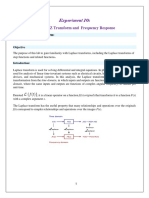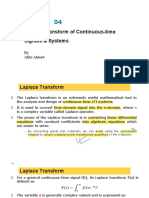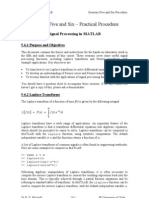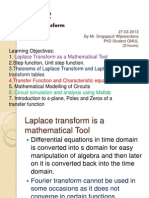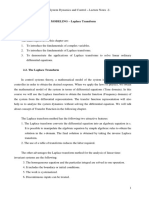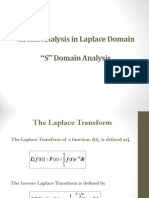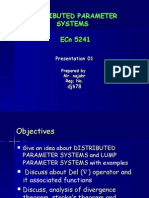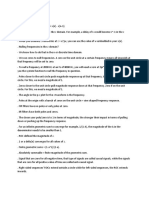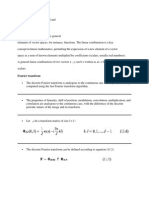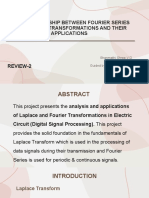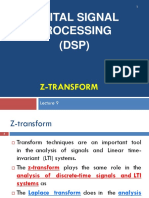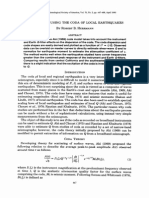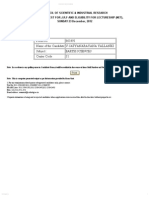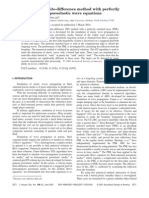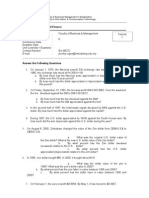Z Transform
Z Transform
Uploaded by
gptkoushikCopyright:
Available Formats
Z Transform
Z Transform
Uploaded by
gptkoushikCopyright
Available Formats
Share this document
Did you find this document useful?
Is this content inappropriate?
Copyright:
Available Formats
Z Transform
Z Transform
Uploaded by
gptkoushikCopyright:
Available Formats
Z
Z Z
4
z-Transform
4.1 4.2 4.3 4.4 4.5 4.6 4.7
Z Z Z
x(m)
z k
x(mk)
Introduction z-Transform The Z-Plane and the Unit Circle Properties of the z-transform Transfer Function, Poles and Zeroes Physical Interpretation of Poles and Zeroes The Inverse z-transform
-transform, like the Laplace transform, is an indispensable mathematical tool for the design, analysis and monitoring of systems. The z-transform is the discrete-time counter-part of the Laplace transform and a generalisation of the Fourier transform of a sampled signal. Like Laplace transform the z-transform allows insight into the transient behaviour, the steady state behaviour, and the stability of discrete-time systems. A working knowledge of the z-transform is essential to the study of digital filters and systems. This chapter begins with the definition of the Laplace transform and the derivation of the z-transform from the Laplace transform of a discrete-time signal. A useful aspect of the Laplace and the z-transforms are the representation of a system in terms of the locations of the poles and the zeros of the system transfer function in a complex plane. In this chapter we derive the so-called zplane, and its associated unit circle, from sampling the s-plane of the Laplace transform. We study the description of a system in terms the system transfer function. The roots of the transfer function, the so-called poles and zeros of transfer function, provide useful insight into the behaviour of a system. Several examples illustrating the physical significance of poles and zeros and their effect on the impulse and frequency response of a system are considered.
Sec. 4.1 Introduction
4.1 Introduction The Laplace transform and its discrete-time counterpart the z-transform are essential mathematical tools for system design and analysis, and for monitoring the stability of a system. A working knowledge of the z-transform is essential to the study of discretetime filters and systems. It is through the use of these transforms that we formulate a closed-form mathematical description of a system in the frequency domain, design the system, and then analyse the stability, the transient response and the steady state characteristics of the system. A mathematical description of the input-output relation of a system can be formulated either in the time domain or in the frequency domain. Time-domain and frequency domain representation methods offer alternative insights into a system, and depending on the application it may be more convenient to use one method in preference to the other. Time domain system analysis methods are based on differential equations which describe the system output as a weighted combination of the differentials (i.e. the rates of change) of the system input and output signals. Frequency domain methods, mainly the Laplace transform, the Fourier transform, and the z-transform, describe a system in terms of its response to the individual frequency constituents of the input signal. In section 4.?? we explore the close relationship between the Laplace, the Fourier and the z-transforms, and the we observe that all these transforms employ various forms of complex exponential as their basis functions. The description of a system in the frequency domain can reveal valuable insight into the system behaviour and stability. System analysis in frequency domain can also be more convenient as differentiation and integration operations are performed through multiplication and division by the frequency variable respectively. Furthermore the transient and the steady state characteristics of a system can be predicted by analysing the roots of the Laplace transform or the z-transform, the so-called poles and zeros of a system.
4.2 Derivation of the z-Transform
The z-transform is the discrete-time counterpart of the Laplace transform. In this section we derive the z-transform from the Laplace transform a discrete-time signal. The Laplace transform X(s), of a continuous-time signal x(t), is given by the integral
X ( s ) = x(t )e st dt
0
(4.1)
Chap. 4 z-Transform
where the complex variable s= +j, and the lower limit of t=0 allows the possibility that the signal x(t) may include an impulse. The inverse Laplace transform is defined by
1 + j
x(t ) =
X (s)e
1
st
ds
(4.2)
where 1 is selected so that X(s) is analytic (no singularities) for s>1. The ztransform can be derived from Eq. (4.1) by sampling the continuous-time input signal x(t). For a sampled signal x(mTs), normally denoted as x(m) assuming the sampling period Ts=1, the Laplace transform Eq. (4.1) becomes
X (e s ) =
m =0
x ( m )e
sm
(4.3)
Substituting the variable e s in Eq. (4.3) with the variable z we obtain the one-sided ztransform equation
X ( z) =
m =0
x ( m) z
(4.4)
The two-sided z-transform is defined as
X ( z) =
m =
x ( m) z
(4.5)
Note that for a one-sided signal, x(m)=0 for m<0, Eqs. (4.4) and (4.5) are equivalent.
4.2.1 The Relationship Between the Laplace, the Fourier, and the z-Transforms
The Laplace transform, the Fourier transform and the z-transform are closely related in that they all employ complex exponential as their basis function. For right-sided signals (zero-valued for negative time index) the Laplace transform is a generalisation
Sec 4.2 Derivation of the z-Transform
of the Fourier transform of a continuous-time signal, and the z-transform is a generalisation of the Fourier transform of a discrete-time signal. In the previous section we have shown that the z-transform can be derived as the Laplace transform of a discrete-time signal. In the following we explore the relation between the ztransform and the Fourier transform. Using the relationship
z = e s = e e j = re j2f
rmIm[ej2mf] rmIm[ej2mf] rmIm[ej2mf]
(4.6)
r<1 Figure 4.1 The z-transform basis functions.
r =1
r >1
where s=+j and =2f, we can rewrite the z-transform Eq. (4.4) in the following form
X ( z) =
m =0
x ( m) r
m j2mf
(4.7)
Note that when r =e=1 the z-transform becomes the Fourier transform of a sampled signal given by
X ( z = e j2f )=
m =
x ( m)e
j2fm
(4.8)
Therefore the z-transform is a generalisation of the Fourier transform of a sampled signal derived in sec. 3.xx. Like the Laplace transform, the basis functions for the ztransform are damped or growing sinusoids of the form z m = r m e j2fm as shown in Fig. 4.1. These signals are particularly suitable for transient signal analysis. The Fourier basis functions are steady complex exponential, e j2fm , of time-invariant amplitudes and phase, suitable for steady state or time-invariant signal analysis.
Chap. 4 z-Transform
A similar relationship exists between the Laplace transform and the Fourier transform of a continuous time signal. The Laplace transform is a one-sided transform with the lower limit of integration at t = 0 , whereas the Fourier transform Eq. (3.21) is a twosided transform with the lower limit of integration at t = . However for a one-sided signal, which is zero-valued for t < 0 , the limits of integration for the Laplace and the Fourier transforms are identical. In that case if the variable s in the Laplace transform is replaced with the frequency variable j2f then the Laplace integral becomes the Fourier integral. Hence for a one-sided signal, the Fourier transform is a special case of the Laplace transform corresponding to s=j2f and =0.
Example 4.1 Show that the Laplace transform of a sampled signal is periodic with respect to the frequency axis j of the complex frequency variable s= +j. Solution: In Eq. (4.3) substitute s+jk2, where k is an integer variable, for the frequency variable s to obtain
X (e s + jk 2 ) =
=
m =
x(m)e ( s + jk 2 ) m =
sm
m =
x ( m)e
sm
jk 2m e 123 =1
m =
x ( m)e
(4.9)
= X (e )
Hence the Laplace transform of a sample signal is periodic with a period of 2 as shown in Fig. 4.2.a
4.3 The z-Plane and The Unit Circle
The frequency variables of the Laplace transform s= +j, and the z-tranform z=re are complex variables with real and imaginary parts and can be visualised in a two dimensional plane. Figs. 4.2.a and 4.2.b shows the s-plane of the Laplace transform and the z-plane of z-transform. In the s-plane the vertical jaxis is the frequency axis, and the horizontal -axis gives the exponential rate of decay, or the rate of growth, of the amplitude of the complex sinusoid as also shown in Fig. 4.1. As shown
j
Sec 4.3 The z-plane, The Unit Circle
The j axis of the s-plane is the location of the Fourier basis functions
j . . .
Im
S-Plane
Inside the unit circle corresponds to the <0 part of the s-plane
Z-Plane
Outside the unit circle corresponds to >0 part of the s-plane
3 2
- -2 -3 The unit circle corresponds to the j axis of the s-plan, it is the location of the Fourier basis functions
Re
. . .
(a)
Figure 4.2 - Illustration of (a) the S-plane and (b) the Z-plane.
(b)
in example 4.1 when a signal is sampled in the time domain its Laplace transform, and hence the s-plane, becomes periodic with respect to the jaxis. This is illustrated by the periodic horizontal dashed lines in Fig 4.2.a. Periodic processes can be conveniently represented using a circular polar diagram such as the z-plane and its assciated unit circle. Now imagine bending the jaxis of the s-plane of the sampled signal of Fig. 4.2.a in the direction of the left hand side half of the s-plane to form a circle such that the points and meet. The resulting circle is called the unit circle, and the resulting diagram is called the z-plane. The area to the left of the s-plane, i.e. for < 0 or r =e<1, is mapped into the area inside the unit circle, this is the region of stable causal signals and systems. The area to the right of the s-plane, > 0 or r=e>1, is mapped onto the outside of the unit circle this is the region of unstable signals and systems. The jaxis, with =0 or r =e=1, is itself mapped onto the unit circle line. Hence the cartesian co-ordinates used in s-plane for continuous time signals Fig. 4.2.a, is mapped into a polar representation in the z-plane for discrete-time signals Fig 4.2.b. Fig. 4.3 illustrates that an angle of 2, i.e. once round the unit circle, corresponds to a frequency of Fs Hz where Fs is the sampling frequency. Hence a frequency of f Hz corresponds to an angle given by
2 f Fs
radians
(4.10)
For example at a sampling rate of Fs=40 kHz, a frequency of 5 kHz corresponds to an angle of 25/40= 0.05 radians or 45 degrees.
Chap. 4 z-Transform
Im Fs/4 Hz Z-Plane
Fs/2 Hz
0 Hz Fs Hz
Re
3Fs/4 Hz
Figure 4.3 - Illustration of mapping a frequency of f Hz to an angle of radians.
4.3.1 The Region of Convergence (ROC)
Since the z-transform is an infinite power series, it exists only for those values of the variable z for which the series converges to a finite sum. The region of convergence (ROC) of X(z) is the set of all the values of z for which X(z) attains a finite computable value.
Example 4.2 Determine the z-transform, the region of convergence, and the Fourier transform of the following signal
x(m)
1 m = 0 x ( m) = ( m) = 0 m 0
m
(4.11)
Solution: Substituting for x(m) in the z-transform Eq. (4.4) we obtain
Sec 4.3 The z-plane, The Unit Circle
Im
X ( z) =
m =
x ( m) z
= ( 0) z 0 = 1
(4.12)
Re
For all values of the variable z we have X(z)=1, hence as shown in the shaded area of the left hand side figure the region of convergence is the entire z-plane. The Fourier transform of x(m) may be obtained by evaluating X(z) in Eq. (4.12) at z = e j as X ( e j ) = 1 (4.13)
Example 4.3 Determine the z-transform, the region of convergence, and the Fourier transform of the following signal
x(m)
1 m = k x ( m) = ( m k ) = 0 m k
k m
(4.14)
Solution: Substituting for x(m) in the z-transform Eq. (4.4) we obtain
Im
X ( z) =
m =
(m k ) z
= z k
(4.15)
Re
The z-transform is X ( z ) = z k = 1 / z k . Hence X(z) is finite-valued for all the values of z except for z=0. As shown by the shaded area of the left hand side figure, the region of convergence is the entire z-plane except the point z=0. The Fourier transform is obtained by evaluating X(z) in Eq. (4.15) at z = e j as X (e j ) = e jk (4.16)
Chap. 4 z-Transform
Example 4.4 Determine the z-transform, the region of convergence, and the Fourier transform of the following signal
x(m)
1 m = k x ( m) = ( m + k ) = 0 m k
-k m
(4.17)
Solution: Substituting for x(m) in the z-transform Eq. (4.4) we obtain
Im
X ( z) =
m =
x ( m) z
= zk
(4.18)
Re
The z-transform is X ( z ) = z k . Hence X(z) is finitevalued for all the values of z except for z = . As shown by the shaded area of the left hand side figure, the region of convergence is the entire z-plane except the point z = which is not shown. The Fourier transform is obtained by evaluating X(z) in Eq. (4.18) at z = e j as
X (e j ) = e jk
(4.19)
Example 4.5 Determine the z-transform, the region of convergence, and the Fourier transform of the following signal
x(m)
1 m = k x ( m) = ( m + k ) + ( m k ) = 0 m k
-k k m
(4.20)
10
Sec 4.3 The z-plane, The Unit Circle
Solution: Substituting for x(m) in the z-transform Eq. (4.4) we obtain
Im
X ( z) =
m =
x ( m) z
= z k + z k
(4.21)
Re
The z-transform is Hence X(z) is finite-valued for all the values of z except for z=0 and z = . As shown by the shaded area of the left hand side figure, the region of convergence is the entire z-plane except the points z=0 and z = not shown. The Fourier transform is obtained by evaluating Eq. (4.21) at z = e j as
X (e j ) = e jk + e + jk = 2 cos(k )
Example 4.6 Determine the z-transform and region of convergence of
x(m)
m x (m) = 0 m0 m<0
(4.22)
(4.23)
Solution: Substituting for x(m) in the z-transform Eq. (4.4) we obtain
Im
Unit Circle
X ( z )=
m =
x ( m) z m =
m =0
m z m = z 1
m =0
(4.24)
Re
This infinite power series converges only if | z 1 | < 1 . Therefore the ROC is |z|>||. As shown by the shaded area of the left hand side figure, the region of convergence excludes a disc of radius .
Chap. 4 z-Transform
11
Example 4.7 Determine the z-transform and region of convergence of the left-sided sequence x(m)
0 x ( m)= m
m
m0 m<0
(4.25)
Solution: Substituting for x(m) in the z-transform Eq. (4.4) we obtain
Im
Unit Circle
X ( z )=
m =
x ( m) z m =
m =
m z m = 1 z
m =0
(4.26)
1
Re
This infinite power series converges only if | z|<1. Therefore the ROC is |z|<||. As shown by the shaded area of the left hand side figure, the region of convergence is confined to a disc of radius .
Example 4.7 Determine the z-transform and region of convergence of the left-sided sequence
m x ( m)= m
x(m)
m0 m<0
(4.27)
Solution: Substituting for x(m) in the z-transform Eq. (4.4) we obtain
12
Sec 4.3 The z-plane, The Unit Circle
Im
Unit Circle
X ( z )=
m =
x ( m) z
m =0
m =0
z m +
m =
z m (4.28)
Re
X ( z )=
( z ) + ( z )
1 m 1
m =1
(4.29)
1
This infinite power series converges only if |z- |<1 1 and | z|<1. As shown by the shaded area of the left hand side figure, the region of convergence corresponds to the area of < z < .
4.4 Properties of the z-Transform
As z-transform is a generalisation of the Fourier transform of a sampled signal it has similar properties to the Fourier Transform as described in the following.
Linearity Given two signals
z
x1 (m) X 1 ( z ) and x 2 ( m) X 2 ( z )
z
(4.30) (4.31)
then the linearity implies that for any linear combination of x1(m) and x2(m) we have a1 x1 (m) + a 2 x 2 (m) a1 X 1 ( z ) + a 2 X 2 ( z ) Eq. (4.32) is known as the superposition principle.
Example 4.7 Given the following two signals
z
(4.32)
Chap. 4 z-Transform
13
x(m) b a -k
x1 (m) = (m k ) x 2 (m) = (m + k )
m
(4.33) (4.34)
Determine the z-transform of x(m) = a x1 (m k ) + bx 2 (m + k )
Solution: Substituting for x(m) in the z-transform Eq. (4.4) we obtain
(4.35)
X ( z) = =
m =
(a (m k ) + b (m + k ))z
m
m =
a ( m k ) z
m =
b ( m + k ) z
(4.36)
m
=az
+ bz
+k
It is clear in the second line of the above solution that the z-transform of the combination of two time domain signals x(m)=x1(m)+x2(m) can be written as the sum of the z-transforms of the individual signals x1(m) and x2(m).
Time Shifting The variable z has a useful interpretation in terms of time delay. If
x ( m) X ( z ) then x(m k ) z k X ( z ) This property can be proved by taking the z-transform of x(mk) X ( z) =
z
(4.37)
m =
x(m k ) z m =
n =
x ( n) z ( n + k ) = z k
n =
x ( n) z
= z k X ( z)
(4.38)
14
Sec 4.4 Properties of the z-Transform
where we have made a variable substitution n=mk. That is the effect of a time shift by k sampling-interval-time units is equivalent to multiplication of the z-transform by 1 +1 zk. Note that z delays the signal by 1 unit and z-k by k units, and z is a noncausal unit time advance, and z+k advances a signal in time by k units.
x(m)
x(mk)
x(m)
+k
x(m+k)
(a) Causal k-unit delay
(b) Noncausal k-unit advance
Figure 4.4 Illustration of the variable z-k as k-unit delay operator.
Example 4.8 Determine the z-transform and region of convergence of a time-delayed version of example 4.6 given as
x(m)
m k x ( m)= 0
mk m<0
(4.39)
Solution: Substituting for x(m) in the z-transform Eq. (4.4) we obtain
X ( z )=
m =
x ( m) z m =
m=k
m k z m = z k m k z ( m k )
m=k k m =0
=z
m =0
=z
(z )
(4.40)
1 m
This infinite power series converges only if |z-1|<1 and z 0 . Therefore the ROC is | z| >| | which excludes z=0 as required..
Chap. 4 z-Transform
15
Multiplication by an Exponential Sequence (Frequency Modulation)
The z-transform relation for the product of a signal x(m) and the exponential sequence m z0 is
zm x ( m) X ( z / z 0 ) 0
z z
(4.41)
x(m) X ( z / z 0 ) in the z-transform this property can be shown by substituting z m 0 equation
m =
m x ( m) z m = 0 z
m=k
x(m)( z / z
0)
= X ( z / z0 )
(4.42)
Note that for the case when z = e j and z 0 = e j 0 then we have the frequency modulation equation e j0m x(m) X (e j( 0 ) )
Convolution For two signals x1(m) and x2(m)
F
(4.43)
x1 (m) X 1 ( z ) x 2 ( m) X 2 ( z ) the convolutional property states that x1 (m) x 2 (m) X 1 ( z ) X 2 ( z )
z z
(4.44)
where the asterisk sign * denotes the convolution operation. That is the convolution of two signals in the time domain is equivalent to multiplication of their z-transforms and vice versa.
Differentiation in the z-Domain Given
x ( m) X ( z ) then
16
Sec 4.4 Properties of the z-Transform
mx( m) z dX ( z ) dz
(4.45)
This property can be proved by taking the derivative of the z-transform equation w.r.t. the variable z as
d X ( z) d = x(m) z m = mx(m) z m 1 dz d z m = m=
= z
m =
m x ( m) z
(4.46)
4.5 Transfer Function, Poles and Zeros
Consider the general linear time-invariant difference equation describing the inputoutput relationship of a discrete-time linear system y ( m) =
k =1
a k y (m k ) +
b x( m k )
k k =0
(4.47)
In Eq. (4.47) the signal x(m) is the system input, y(m) is the system output, and ak and bk are the system coefficients. Taking the z-transform of Eq. (4.47) we obtain Y ( z) =
k =1
a k z k Y ( z ) +
b z
k k =0
X ( z)
(4.48)
Eq. (4.48) can be rearranged and expressed in terms of the ratio of a numerator polynomial Y(z) and a denominator polynomial X(z) as Y ( z ) b0 + b1 z 1 +L+ bM z M = H ( z) = = X ( z ) 1 a1 z 1 L a N z N
bz
1
k =0 N k =1
az
(4.49)
k
H(z) is known as the system transfer function. The frequency response of a system H() may be obtained by substituting z = e j in Eq. (4.49).
Chap. 4 z-Transform
17
4.5.1 Poles and Zeros
One of the most useful aspects of the z-transform analysis is the description of a system in terms of the so-called poles and zeros of the system. The zeros of a transfer function H(z) are the values of the variable z for which the transfer function (or equivalently its numerator) is zero. Therefore the zeros are the roots of numerator polynomial in Eq. (4.49). The poles of H(z) are the values of the variable z for which H(z) is infinite. This happens when the denominator of H(z) is zero. Therefore the poles of H(z) are the roots of the denominator polynomial of Eq. (4.49). To obtain the poles and zeros of H(z) rewrite the numerator and denominator polynomials to avoid negative powers of the variable z as
H ( z) =
b0 z M z N
z M + (b1 b0 )z M 1 +L+ (bM b0 ) z N a1 z N 1 L a N
(4.50)
Now the numerator and denominator polynomials of H(z) may be factorised and expressed as H ( z ) = b0 z M + N or
(z z1 )(z z 2 )L (z z M ) (z p1 )(z p 2 )L (z p N )
M + N
(4.51)
H ( z) = G z
(z z )
k
(z p )
k k =1
k =1 N
(4.52)
where the gain G=b0, and zks are the zeros and pks the poles of H(z) respectively. Thus the transfer function H(z) has M finite zeros i.e. the roots of the numerator polynomial at z=z1, z2, ..., zM, N finite poles i.e. the roots of the denominator polynomial at z=p1, p2, ...,pN, and |N-M| zeros (if N > M), or poles (if N < M), at the origin z=0. Poles or zeros may also occur at z = . A zero exists at infinity if H ( z = ) = 0 and a pole exists at infinity if H ( z = ) = . If we count the number of poles and zeros at zero and infinity we find that H(z) has exactly the same number of poles as zeros. A further important point to note is that for a system with real-valued coefficients ak and bk, complex-valued poles or zeros always occur in complex conjugate pairs. The description of a system in terms of its poles and zeros is an extremely useful abstraction of a system. The poles represent the roots of the feedback part of the transfer function of a system. For a stable system the poles should have a magnitude of
18
Sec 4.5 Transfer Functions, Poles and Zeros
less than one and lie inside the unit circle as shown in the following examples. The zeros represent the roots of the feed forward part of the transfer function of a system. There is no restriction on the values of zeros other than that required to obtain a desired frequency or impulse response. A useful graphical abstraction of the transfer function of a discrete-time system H(z) is the pole-zero plot in a complex polar plane. The location of the poles are shown by crosses () and the locations of the zeros by circles (O) as described in the following examples.
Example 4.9 Find the z-transform and plot the pole-zero diagram of the following right-sided discrete-time signal
m x (m) = 0
m0 m<0
Im
(4.53)
x(m)
Re
m
(a) (b)
Figure 4.5 (a) An exponentially decaying signal, (b) The pole-zero representation of the signal in (a).
Solution: Substituting for x(m) in the z-transform Eq. (4.4) we obtain
X ( z) =
m =0
m m
(z )
m =0
1 m
(4.54)
For |a|<1, using the convergence formula for a geometic series in appendix A, this power series converges to
Chap. 4 z-Transform
19
X ( z) =
1 1 z
1
z z
(4.55)
Therefore X(z) in this case has a single zero at z=0 and a single pole at z=. The polezero plot is shown in Fig 4.5.b.
4.5.2 The Response of a Single (First-Order) Zero or Pole
The effect of a first order zero is to introduce a deep or trough in the frequency spectrum of the signal at the frequencies 0 or radians, where corresponds to half the sampling frequency. The effect of a first order pole is to introduce a peak in the frequency spectrum of the signal at frequencies 0 or . These are illustrated in the following examples. Example 4.10 Consider the first order feed forward system of Fig 4.6 given by y ( m) = x(m 1) + x(m) (4.56)
x(m)
z1
+
y(m)
Figure 4.5 (a) A first-order feed forward discrete-time system.
Taking the z-transform of Eq. (4.56) yields Y ( z ) = z 1 X ( z ) + X ( z ) = X ( z )(1 + z 1 ) From Eq. (4.57) the z-transfer function is given by (4.57)
H ( z) =
Y ( z) = 1 + z 1 X ( z)
(4.58)
20
Sec 4.5 Transfer Functions, Poles and Zeros
Equating H(z)=0 yields a zero at z = . Substituting z = e j in Eq. (4.58) yields the frequency response H (e j ) = 1 + e j (4.59) Now at an angular frequency =0, H(0)=1+ and at =; H()=1. Hence when =1, H(0)=0. Fig. 4.6 shows the variation of the frequency response of the first order
x(m)
x(m)
> 0
1 m 1 m
<0
0.8
0.8
Magnitude |H(f)|
0.6
0.6
=-0.5
0.4
=0.5
0.4
=-.7
0.2
=.7 =-1
0.2
=1
0
Frequency
Fs/2
Frequency
Fs/2
Figure 4.6 Illustration of the impulse response, the pole-zero diagram, and the frequency response of a first order system with a single zero, for the varying values of the zero .
Chap. 4 z-Transform
21
single-zero system with the radius of the zero . On the frequency axis the angular frequency = corresponds to a frequency of Fs/2 Hz where Fs is the sampling rate. Note that for the positive values of the system has a high-pass frequency response, and conversely for the negative values of the system has a low-pass frequency response.
Example 4.11 Consider the first order feedback system of Fig 4.7 given by
y (m) = y (m 1) + x( m)
(4.60)
x(m)
z-1
y(m)
Figure 4.7 (a) A first order feedback discrete-time system.
Taking the z-transform of Eq. (4.60) yields Y ( z ) = z 1Y ( z ) + X ( z ) From Eq. (4.61) the transfer function is given by H ( z) = 1 Y ( z) z = = 1 X ( z) 1 z z (4.62) (4.61)
The transfer function H(z) has a pole at z= and a zero at the origin. Substituting z = e j in Eq. (4.58) gives the frequency response 1 H ( e j ) = 1 e j
(4.63)
Now at =0; H(0)=1/(1) and at =; H()=1/(1+). Fig. 4.8 shows the variation of the frequency response of the first order single-pole system with the pole radius . On the frequency axis the angular frequency = corresponds to a frequency of Fs/2
22
Sec 4.5 Transfer Functions, Poles and Zeros
Hz where Fs is the sampling rate. Note that for the positive values of the system has a low-pass frequency response, and conversely for the negative values of the system has a high-pass frequency response.
x(m)
x(m)
>0
m
<0
m
1 0.8
1 0.8
Magnitude |H(f)|
0.6 0.4
=0.5 =0.75 =0.9
0.6 0.4 0.2 0 0
= 0.5 = 0.75 = 0.9
0.2 0 0
Frequency
fs/2
Frequency
fs/2
Figure 4.8 Illustration of the impulse response, the pole-zero diagram, and the frequency response of a first order system with a single pole, for the varying values of the pole radius .
Chap. 4 z-Transform
23
4.5.3 The Response of a Second Order Pair of Zeroes or Poles
The effect of a second order pair of zeros is to introduce a deep or trough in the frequency spectrum of the signal at a frequency that depends on the angular position of the zeros. The effect of a second order pair of poles is to introduce a peak in the frequency spectrum of the signal at a frequency that depends on the angular position of the poles in the unit circle.
Example 4.12 Consider the second order feed forward system of Fig 4.9 given by
y (m) =b0 x(m) + b1 x(m 1) + b2 x(m 2)
(4.64)
x(m) b0
z-1 b1
z-1 b2
+
y(m)
Figure 4.9 (a) A second-order feed forward discrete-time system.
Taking the z-transform of Eq. (4.64) yields
Y ( z ) = b0 X ( z ) + b1 z 1 X ( z ) + b2 z 2 X ( z )
From Eq. (4.65) the transfer function is given by H ( z) = Y ( z) = b0 + b1 z 1 + b2 z 2 X ( z)
(4.65)
(4.66)
Eq. (4.66) can be factorised and expressed in terms of the zeros of the transfer function as
24
Sec 4.5 Transfer Functions, Poles and Zeros
* 1 H ( z ) = G 1 z1 z 1 1 z1 z
)(
(4.67)
where the gain factor G=b0. Note that since the coefficients of the transfer function polynomial in Eq. (4.62) are real-valued, the roots of the polynomial have to be either complex conjugates or real-valued. For a pair of complex conjugate poles z1 = re j
* and z1 = re -j Eq. (4.67) can be written in a polar form in terms of the angular frequency and the radius of the poles r as
H ( z ) = G 1 re j z 1 1 re j z 1
1
( )( = G (1 2r cos( ) z
+ r 2 z 2
) )
2
(4.68)
Comparing Eqs. (4.62) and (4.64) we have b0=G, b1=2rcos() and b2=r .
Chap. 4 z-Transform
25
y(m) 1.0 cos() 1.0
y(m)
1.0 r2
Magnitude |H(f)|
0.8
0.8
r = 0.5
0.6 0.6
0.4
0.4
r =0.75 r =1
0
=/2
0.2
=/4
0
=3/4
0.2
Frequency
Fs/2
Frequency
Fs/2
Figure 4.10 Illustration of the impulse response, the pole-zero diagram, and the frequency response of a second order system with a a pair of complex conjugate zeros, for the varying values of the angular position and the radius r of the zeros.
Fig. 4.10.a illustrates the variation of the zero-frequency with the angular position of the zeros for a complex conjugate pair of zeros. Fig. 4.10.b illustrates the variation of the depth and the bandwidth the trough introduced by a complex conjugate pair of zeros with the radius of the zeros.
Example 4.13 Consider the second order feedback system of Fig. 4.11 given by
26
Sec 4.5 Transfer Functions, Poles and Zeros
y ( m) =a 2 y (m 2) + a1 y (m 1) + g x( m)
(4.65)
x(m)
+
a2 z-1 a1 z-1
y(m)
Figure 4.11 (a) A second-order feed back discrete-time system.
Taking the z-transform of Eq. (4.65) we have Y ( z ) =a 2 z 2Y ( z ) + a1 z 1Y ( z ) + gX ( z ) Rearranging Eq. (4.66) we obtain the z-transfer function H ( z) = Y ( z) g = 1 X ( z ) 1 a1 z a 2 z 2 (4.67) (4.66)
Eq. (4.67) can be expressed in terms of the poles of the z-transfer function as H ( z) =
g * 1 1 z1 z 1 z1 z
1
)(
(4.68)
where g=1/a0. Note that since the coefficients of the polynomial H(z) are real-valued, the roots of this polynomial have to be either complex conjugate or real. For a pair of * = re -j Eq. (4.68) can be rewritten in a polar complex conjugate poles z1 = re j and z1 form in terms of the angular frequency and the radius of the poles as
H ( z) =
(1 re
)(
g 1 re j z 1
g = 1 2r cos( ) z 1 + r 2 z 2
(4.69)
Chap. 4 z-Transform
27
y(m)=2rcos()y(m1)+r2y(m2)+(m) 1.0
y(m)=r2y(m2)+(m) 1.0
=/4
=/2
=3/4
0.8
Magnitude |H(f)|
0.8
r=0.5
0.6 0.6
0.4
0.4
r=0.75 r=0.95
0
0.2 0.2 0
Frequency
Fs/2
Frequency
Fs/2
Figure 4.102 Illustration of the impulse response, the pole-zero diagram, and the frequency response of a second order system with a pair of complex conjugate zeros, for the varying values of the the angular position and the radius of the zeros.
Fig. 4.12.a illustrates the variation of the resonance frequency with the angular position of the poles for a complex conjugate pair of poles. Fig. 4.12.b illustrates the variation of the bandwidth of the resonance from a complex conjugate pair of poles with the radius of the poles.
4.6 Inverse z-Transform
The inverse z-transform can be obtained using one of two methods: (a) the inspection method, (b) the partial fraction method. In the inspection method each simple term of a polynomial in z, H(z), is substituted by its time-domain equivalent. For the more complicated functions of z, the partial fraction methods is used to describe the polynomial in terms of simpler terms, and then each simple term is substituted by its time-domain equivalent term.
4.6.1 Inverse z-transform by Inspection
In this method the discrete-time equation for a signal or a system is obtained from its z-transform by recognising simple z-transform pairs and substituting the time domain terms for their corresponding z-domain terms.
Example 4.13 Find the inverse z-transform of
H ( z) =
Solution: From Eq. (4.70) we have
Y ( z) 1 = X ( z ) 1 z 1
(4.70)
Y ( z ) = z 1Y ( z ) + X ( z )
k k
(4.71)
By inspection and through the substitution of z Y(z) for y(mk) and z X(z) for x(mk) we obtain the discrete-time equivalent of Eq. (4.71) y ( m) = y ( m k ) + x ( m) Now if the input x(m) is a discrete-time impulse (m) given by (4.72)
( m) =
1 0
m=0 m0
(4.73)
then the output of the feedback system of Eq. () will be m m 0 y ( m) = 0 m < 0 (4.74)
You might also like
- Frongkyting 4-sdDocument28 pagesFrongkyting 4-sdapi-276985927100% (1)
- GasCal 1100 Dilution CalibratorDocument83 pagesGasCal 1100 Dilution Calibratorhacguest8485No ratings yet
- National Geographic History 2018 November (Sistine Splendor)Document100 pagesNational Geographic History 2018 November (Sistine Splendor)ポール ジラサック100% (2)
- Chapter04 Z TransformDocument28 pagesChapter04 Z Transformohenri100No ratings yet
- Z TransformDocument9 pagesZ TransformKiran Googly JadhavNo ratings yet
- Chirp Z Transform AlgorithmDocument7 pagesChirp Z Transform AlgorithmUmesh KrishanthaNo ratings yet
- Laplace, Z Transform and Frequency Response: Experiment 10Document7 pagesLaplace, Z Transform and Frequency Response: Experiment 10Engr Haseena JabbarNo ratings yet
- GVICDocument157 pagesGVICTemitope OniNo ratings yet
- 2.3 Linear Approximation of Physical SystemsDocument3 pages2.3 Linear Approximation of Physical SystemsramNo ratings yet
- Z-Transform: Signal Processing IIDocument19 pagesZ-Transform: Signal Processing IIChrispinus ChristianNo ratings yet
- SASCh 03 Part 1Document12 pagesSASCh 03 Part 1Bkm Mizanur RahmanNo ratings yet
- Lecture 4Document44 pagesLecture 4Zamshed FormanNo ratings yet
- Assignment of Signal and System: Submitted byDocument12 pagesAssignment of Signal and System: Submitted bynaeem444454No ratings yet
- Stockwell-Why Use The S-TransformDocument31 pagesStockwell-Why Use The S-Transformyankees131313No ratings yet
- Digital Control System - CompressedDocument18 pagesDigital Control System - CompressedSukhpal SinghNo ratings yet
- DTSP 2marks PDFDocument20 pagesDTSP 2marks PDFishuNo ratings yet
- Inverse Laplace Transform of A ConstantDocument4 pagesInverse Laplace Transform of A Constanttutorciecle1230% (1)
- CHAPTER 1 Modeling in The Frequency DomainDocument17 pagesCHAPTER 1 Modeling in The Frequency DomainAnnette TageufoueNo ratings yet
- Discrete Time Fourier Series Properties: Magnitude Spectrum of X (N), and A Plot ofDocument11 pagesDiscrete Time Fourier Series Properties: Magnitude Spectrum of X (N), and A Plot ofSk Umesh UmeshNo ratings yet
- Laplas TransformDocument17 pagesLaplas TransformRatnakar PatilNo ratings yet
- Laplace TransformDocument98 pagesLaplace TransformMihail ColunNo ratings yet
- Frequency Domain ProcessingDocument42 pagesFrequency Domain ProcessingInJune YeoNo ratings yet
- Fourier Transform and Its Medical ApplicationDocument55 pagesFourier Transform and Its Medical Applicationadriveros100% (1)
- 56 Minutes: Z-Transform PropertiesDocument6 pages56 Minutes: Z-Transform PropertiesFatmir KelmendiNo ratings yet
- Fifth&Sixth ProcedureDocument11 pagesFifth&Sixth ProcedureAmir RabbaniNo ratings yet
- The Z-Transform and Discrete-Time Lti SystemsDocument78 pagesThe Z-Transform and Discrete-Time Lti SystemsKevin Angelo MaNo ratings yet
- Transform: of Technique For For Which - For Which That ofDocument119 pagesTransform: of Technique For For Which - For Which That ofsk abdullahNo ratings yet
- Application of Laplace TransformDocument35 pagesApplication of Laplace TransformSingappuli100% (1)
- ME 3001-Lecture 2 - Laplace Transform - 2017 - 18Document17 pagesME 3001-Lecture 2 - Laplace Transform - 2017 - 18vahitNo ratings yet
- Notes On Micro Controller and Digital Signal ProcessingDocument70 pagesNotes On Micro Controller and Digital Signal ProcessingDibyajyoti BiswasNo ratings yet
- Why Z-Transform?: A Generalization of Fourier Transform Why Generalize It?Document57 pagesWhy Z-Transform?: A Generalization of Fourier Transform Why Generalize It?De BuNo ratings yet
- Z TransformDocument156 pagesZ TransformMohammad Rameez100% (1)
- MITRES 6-010S13 Chap03 PDFDocument47 pagesMITRES 6-010S13 Chap03 PDFSrinyantu ChatterjeeNo ratings yet
- Q. 1. Define Z-Transform of A Discrete Time Signal. Ans. The Z-Transform of A Discrete Time Signal X (N)Document19 pagesQ. 1. Define Z-Transform of A Discrete Time Signal. Ans. The Z-Transform of A Discrete Time Signal X (N)Mirbaz PathanNo ratings yet
- Discrete Fourier TransformDocument12 pagesDiscrete Fourier TransformnaruatNo ratings yet
- Circuit Analysis in S-DomainDocument22 pagesCircuit Analysis in S-Domainshreyas_stinsonNo ratings yet
- Topic 4. Frequency ResponseDocument9 pagesTopic 4. Frequency ResponseFadzai FunguraNo ratings yet
- Aaaaaaa As ADocument17 pagesAaaaaaa As ANuwan SenevirathneNo ratings yet
- Z-Transform Representation of Discrete-Time Signals and SystemsDocument40 pagesZ-Transform Representation of Discrete-Time Signals and SystemsFreddy PesantezNo ratings yet
- DSP Exam AidDocument7 pagesDSP Exam AidAnonymous cYhhyVNo ratings yet
- Laplace TransformDocument24 pagesLaplace TransformChitransh SharmaNo ratings yet
- Laplace 2Document46 pagesLaplace 2smoothing1No ratings yet
- Time Frequency Representation of Digital Signals and Systems Based On Short TimeDocument15 pagesTime Frequency Representation of Digital Signals and Systems Based On Short TimeNorozKhanNo ratings yet
- Poles, Zeros, and Higher Order FiltersDocument7 pagesPoles, Zeros, and Higher Order FiltersJanNo ratings yet
- Module 4: Laplace and Z Transform Lecture 33: Inverse Laplace and Z TransformDocument3 pagesModule 4: Laplace and Z Transform Lecture 33: Inverse Laplace and Z TransformPrasad KavthakarNo ratings yet
- Frequency Domain Identification For MDOF SystemsDocument5 pagesFrequency Domain Identification For MDOF SystemsrislcNo ratings yet
- Problems Based Exponential and Trigonometric Fourier Series and Its ApplicationsDocument9 pagesProblems Based Exponential and Trigonometric Fourier Series and Its ApplicationsKhushbu ThakurNo ratings yet
- Z-Plane Synthesis of Response Functions and Interpolators in Z-Transformelectromagnetic Transient Analysis in Power SystemsDocument7 pagesZ-Plane Synthesis of Response Functions and Interpolators in Z-Transformelectromagnetic Transient Analysis in Power SystemsranaateeqNo ratings yet
- Fast Fourier TransformDocument15 pagesFast Fourier TransformRobin GhalotNo ratings yet
- Speech AssignmentDocument4 pagesSpeech AssignmentAnithPalatNo ratings yet
- Fourier TransformDocument8 pagesFourier TransformAnthony LunaNo ratings yet
- Z TransformDocument10 pagesZ TransformSuvra PattanayakNo ratings yet
- 21bma021-Review 2Document17 pages21bma021-Review 2ShanmathiNo ratings yet
- Unit 2 - Z TransformDocument67 pagesUnit 2 - Z Transformchandrani deyNo ratings yet
- DTFT, DFT, FFT PDFDocument14 pagesDTFT, DFT, FFT PDFsamiNo ratings yet
- Bilinear Transform PDFDocument7 pagesBilinear Transform PDFIsh War0% (1)
- Debmalya Dash - Ca1 - Ec504Document10 pagesDebmalya Dash - Ca1 - Ec504Debmalya DashNo ratings yet
- 9 Lec9 DSP Z TransformDocument31 pages9 Lec9 DSP Z TransformAhmed KhalfNo ratings yet
- QMF FilterDocument17 pagesQMF FilterShilpa Badave-LahaneNo ratings yet
- Cals RismanDocument5 pagesCals RismanRisman YusufNo ratings yet
- Harmonic Maps and Minimal Immersions with Symmetries (AM-130), Volume 130: Methods of Ordinary Differential Equations Applied to Elliptic Variational Problems. (AM-130)From EverandHarmonic Maps and Minimal Immersions with Symmetries (AM-130), Volume 130: Methods of Ordinary Differential Equations Applied to Elliptic Variational Problems. (AM-130)No ratings yet
- Dell Precision Towers & Desktop Workstations - Dell India PDFDocument2 pagesDell Precision Towers & Desktop Workstations - Dell India PDFgptkoushikNo ratings yet
- Et At,: by Robert B. HerrmannDocument22 pagesEt At,: by Robert B. HerrmanngptkoushikNo ratings yet
- Source ParametersDocument14 pagesSource ParametersgptkoushikNo ratings yet
- Earthquake MagnitudeDocument4 pagesEarthquake MagnitudegptkoushikNo ratings yet
- RT SeisDocument22 pagesRT SeisgptkoushikNo ratings yet
- Joint Csir-Ugc Test For J.RDocument1 pageJoint Csir-Ugc Test For J.RgptkoushikNo ratings yet
- A Staggered-Grid Finite-Difference Method With Perfectly Matched Layers For Poroelastic Wave EquationsDocument10 pagesA Staggered-Grid Finite-Difference Method With Perfectly Matched Layers For Poroelastic Wave EquationsgptkoushikNo ratings yet
- Tutorial 2 International FinanceDocument2 pagesTutorial 2 International FinanceEmad Uddin ShahidNo ratings yet
- Ust Ethics PWDocument51 pagesUst Ethics PWAlen Joel PitaNo ratings yet
- AIA Integrated Healthcare Solutions GP TCM Clinic Listing (061213)Document39 pagesAIA Integrated Healthcare Solutions GP TCM Clinic Listing (061213)蓉蓉No ratings yet
- Regin FLS304 Flow SwitchDocument2 pagesRegin FLS304 Flow Switchckyee88No ratings yet
- Flare Tower Module M-08: EquipmentDocument1 pageFlare Tower Module M-08: EquipmentChoong K WNo ratings yet
- Sudoku 9Document501 pagesSudoku 9dorco mataNo ratings yet
- Training and Development. FinalDocument46 pagesTraining and Development. FinalRoselle San Buenaventura100% (1)
- NOTICE DV Interview For The Post of ADAADocument8 pagesNOTICE DV Interview For The Post of ADAAnagasaideepikaNo ratings yet
- Human Resources and CultureDocument27 pagesHuman Resources and Cultureashwani2084No ratings yet
- NSC December 2014 Assignment Marking Scheme - FinalDocument5 pagesNSC December 2014 Assignment Marking Scheme - FinalMM PPNo ratings yet
- Solving Problems Involving Systems of Linear Equations in Two Variables Using Substitution Method.Document9 pagesSolving Problems Involving Systems of Linear Equations in Two Variables Using Substitution Method.Ram BoncodinNo ratings yet
- Bbs 4 Year Project Work Proposal Format: BY Tek Bahadur Madai Asst. Prof. Kailali Multiple Campus Dhangadhi KailaliDocument12 pagesBbs 4 Year Project Work Proposal Format: BY Tek Bahadur Madai Asst. Prof. Kailali Multiple Campus Dhangadhi Kailaliresh dhamiNo ratings yet
- Sean Patrick King Master Resume - November 2015 1Document2 pagesSean Patrick King Master Resume - November 2015 1api-253423658No ratings yet
- Taxable Pay Tables Calculator Method: WWW - Hmrc.gov - Uk/payerti/getting-Started/payroll-System - HTMDocument8 pagesTaxable Pay Tables Calculator Method: WWW - Hmrc.gov - Uk/payerti/getting-Started/payroll-System - HTMchc011133No ratings yet
- SPL Ree FracasDocument1 pageSPL Ree FracasLuz Dary Carvajal Mendoza0% (1)
- Literature Searching StrategyDocument14 pagesLiterature Searching StrategyfanyNo ratings yet
- Subject of International LawDocument3 pagesSubject of International LawushbajiiNo ratings yet
- Navarro v. DomagtoyDocument2 pagesNavarro v. DomagtoyGigi LucilleNo ratings yet
- SSD Course PlanDocument5 pagesSSD Course PlanDhamu DharanNo ratings yet
- Omnibus-Sworn-Statement 2Document3 pagesOmnibus-Sworn-Statement 2KèlǐsītǎnKǎPángNo ratings yet
- LecturePlan BI520 22CSH-244Document6 pagesLecturePlan BI520 22CSH-244AjiteshNo ratings yet
- Tutdac 99Document2 pagesTutdac 99baburao_kodavatiNo ratings yet
- Qualnet AssignmentDocument29 pagesQualnet AssignmentMahamod IsmailNo ratings yet
- Solutions For 50 Aptitude Questions On Profit and Loss QuestionsDocument16 pagesSolutions For 50 Aptitude Questions On Profit and Loss QuestionsNaren Dran100% (1)
- Knights of The Dinner Table 083Document92 pagesKnights of The Dinner Table 083Royce A R Porter100% (2)
- Human Resource Management: I. Maintenance and Rewarding of EmployeesDocument43 pagesHuman Resource Management: I. Maintenance and Rewarding of EmployeesChriz Chan67% (3)
- Project Reference List - Spherical Bearings - 20171231Document3 pagesProject Reference List - Spherical Bearings - 20171231Agamoni DasNo ratings yet






